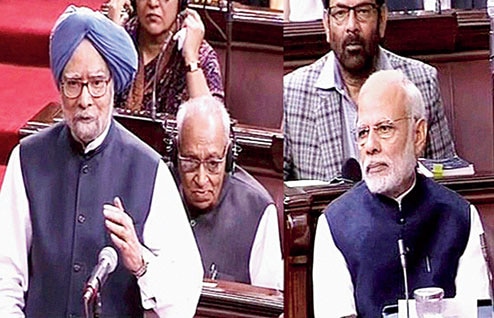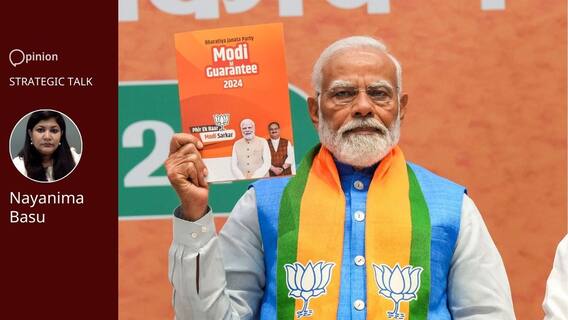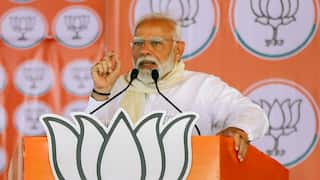Explorer
Advertisement

Just what Congress needed: Manmohan Singh energy drink

Former Prime Minister Manmohan Singh’s speech on demonetisation in the Rajya Sabha on November 24 came as a huge fillip to a beleaguered Congress which has been simply unable to counter Prime Minister Narendra Modi and his Government on any subject of significance.
While the good doctor’s strong words on possible drop in GDP by 2 per cent may not go beyond getting some headlines and igniting TV studio discussions, the presence of a former Prime Minister in the Opposition ranks is something worrying for the ruling dispensation. At a political level, it is worth pondering how the Congress has remained united in spite of suffering its worst electoral performance since India’s independence. The party split in 1977 after a much better performance than in 2014. Yet, since May 2014 till date, the Congress ranks have remained united in spite of murmurings and leadership doubts being raised about Rahul Gandhi.
Does this point to a strategic failure of the Narendra Modi-Amit Shah-led BJP for not exploiting the disquiet, contradictions and personal ambitions in the grand old party?
It has been an open secret that the family of Manmohan Singh has not been too happy the way the former Prime Minister was treated in the second half of the UPA’s rule. Going by some credible accounts, it is also evident that probity-conscious Manmohan Singh was uncomfortable the way Congress managers had got his name and image entangled in the 2G, coal and other alleged scams during the UPA decade.
A cursory look at 1977-78 tells a different story. Barely a month before the general election, senior Congress leaders Jagjivan Ram, HN Bahuguna and Nandini Satpathy quit the Congress, protesting against Sanjay Gandhi and Ambika Soni (she was Youth Congress chief) seeking 100 Lok Sabha tickets for younger members of the party. On February 2, 1977, the ‘J-bomb’ exploded: Jagjivan Ram resigned from the Congress, creating utter panic and a huge sense of demoralisation in the party. Ambika Soni was summoned by Indira Gandhi.
Subsequently, Soni too deserted the Congress and joined the Congress (S), which had Tarkeshwari Sinha, KP Unnikrishnan and Mohammed Yunus Saleem as its key functionaries. Congressmen addressed the breakaway group as the ‘sari and dadhi party’ (‘sari’ to denote Tarkeshwari Sinha and ‘dadhi’ to denote Yunus Saleem’s flowing beard). Apparently Tarkeshwari, Saleem and Unnikrishnan
took away with them many rare books from the party’s Jantar Mantar office.
It was said that several top Janata Party leaders, including Morarji Desai and Chandrashekhar, were instrumental in ‘luring’ Jagjivan Ram, Bahuguna and others. Babjuji’s exit was a huge blow to Indira. She later confided that Jagjivan Ram’s exit from the party and Government had given her the first indication that all was not well and she was going to lose the 1977 election.
In the present day Congress, Rahul Gandhi and Sonia Gandhi are nowhere near Indira’s precarious situation on January 1, 1978, when she was ‘expelled’ from the organisation. The New Year’s Day blow came from none other than the then Congress president, K Brahmananda Reddy, who announced that Indira had been expelled from the party.
Reddy had the support of many powerful leaders such as YB Chavan, Vasant Dada Patil and Swaran Singh. DK Barooah, who had famously coined the slogan, “Indira is India, India is Indira”, was nowhere to be seen. The Congress Working Committee met at the residence of Maragatham Chandrasekhar at 3 Janpath.
Twelve members sided with Indira, but the AICC chief was not in a mood to be accommodative. In the absence of VC Shukla, Bansi Lal, Ambika Soni, Karan Singh and DK Barooah (who had deserted her by then), a somewhat isolated Indira found a new band of loyalists – Buta Singh, AP Sharma, GK Moopanar, Syed Mir Qasim, Maragatham Chandrasekhar and Budh Priya Maurya, all members of the CWC.
They marched to Reddy to challenge Indira’s expulsion. Buta, who was formerly with the Akali Dal, spoke harshly to Reddy, demanding to know how Nehru’s daughter could be expelled from the Congress. “She is the Congress,” Buta had said before walking out of Reddy’s residence.
But it was Indira who had to quit the party and form a breakaway group which met at Mavlankar Hall, New Delhi, to elect her as head of the Congress (Indira). The election symbol was frozen and it took Indira almost two-and-a-half years to stage a comeback.
Throughout 1977and 1978, Janata Party managers worked overtime to engineer defections from the Congress. The idea was to somehow weaken Indira. It is a different matter that the strategy did not work due to Janata Party’s own contradictions and one-upmanship.
What needs to be remembered is that the Congress is the sole national alternative to the BJP. It pulled about 10 crore votes and the Congress’s socio-economic agenda is close to the country’s national life.
Disclaimer: The opinions, beliefs and views expressed by the various authors and forum participants on this website are personal and do not reflect the opinions, beliefs and views of ABP News Network Pvt Ltd.
Follow Blog News on abp LIVE for more latest stories and trending topics. Watch breaking news and top headlines online on abp News LIVE TV
View More
Blog
 “ Reality Check On BJP’s Manifesto Promise Of Permanent UNSC Seat: Elon Musk Won’t Cast Vote, China Will
“ Reality Check On BJP’s Manifesto Promise Of Permanent UNSC Seat: Elon Musk Won’t Cast Vote, China Will

Nayanima Basu
Advertisement
Advertisement
Advertisement
Advertisement
Trending News

for smartphones
and tablets
and tablets

Anand Kochukudy
Opinion
























